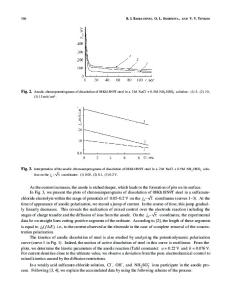Anodic Oxidation of Carbon Steel at High Current Densities and Investigation of Its Corrosion Behavior
- PDF / 1,945,012 Bytes
- 8 Pages / 593.972 x 792 pts Page_size
- 58 Downloads / 325 Views
NTRODUCTION
THERE are several methods that have been developed to form protective oxides on steels such as thermal, chemical, and electrochemical oxidation.[1] Anodic oxidation, so called anodizing, is a simple straightforward method for the production of oxide coatings on the surface of valve metals including Al, Ti, Zr, Hf, W, Nb, V, Zn, and Ta by electrolytic treatment in a suitable solution, which might inhibit the corrosion. Only for aluminum and its alloys and to a lesser extent magnesium, corrosion resistance can be dramatically enhanced by anodic formation of a dense oxide film on a commercial scale.[2,3] Several studies in the literature have reported the anodization of pure iron[4–9] and carbon steels[10,11] in alkaline solutions or ethylene glycol containing NH4F and water for different purposes. Iron oxide films have important applications in electrochemical energy storage,[12] electrohydrodynamic lithography (EHL),[13] electrochemical supercapacitors,[14] and coatings.[15–18] The natural rust is generally a flaky, porous, friable substance, and it provides no protection to the underlying iron-like passive oxide films. Hematite (a-Fe2O3) is known as the main component of iron rust, which forms spontaneously when iron or an alloy that contains iron, is exposed to oxygen and air moisture for a long period of time.[19,20] On the contrary, the magnetite coating which was formed by anodization process act as a dense barrier-type film and it can prevent or minimize the corrosion on iron or steel surface.[21–24]
Burliegh et al.[21,22] reported the formation of an adherent blue-black Fe3O4 (magnetite) film, a light brown or a semi-adherent dichroic iron oxide layer on carbon steel in alkaline solutions. They found that a combination of anodization and final sealing with an inhibiting oil had improved the corrosion behavior. The color of surface oxide coatings depends on the film thickness and the viewing angle. Choi et al.[23] developed an anodizing process for pure iron in 25 pct w/v sodium hydroxide solution at 298 K (25 °C) followed by a subsequent annealing. Through their study, it was found that using the highest current density (100 A/dm2) and annealing at 773 K (500 °C) had the best condition for corrosion prevention. Machmudah et al.[24] developed a hydrothermal electrolysis method (anodizing in a batch autoclave) for preparing a magnetite film on mild steel. These experiments conducted in different conditions of current densities, reaction times, electrolyte concentrations, and temperatures. Electrochemical tests showed that these magnetite layers formed on the steel surface could improve its corrosion behavior effectively. The prior literature investigated the electrochemical behavior of anodized steels in common current densities. Therefore, the main purpose of this study was to evaluate the effect of carbon steel anodic oxidation at high current densities on corrosion behavior. For this purpose, the electrochemical behavior of anodized carbon steel in 3.5 wt pct NaCl solution was investigated by potentiodynamic
Data Loading...











